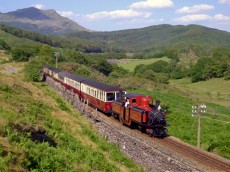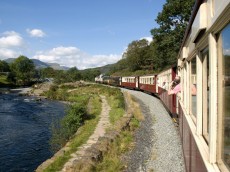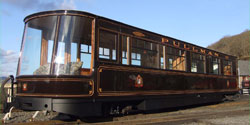

Founded 1953




The Ffestiniog Railway
At more or less the same time as the Tallyllyn was getting under way, efforts were being made forty miles further north along the Cambrian Coast to try to re-open the Ffestiniog Railway. The Ffestiniog was another slate carrying line, operating from Blaenau Ffestiniog, where there were several slate mines, and descending seven hundred feet to Porthmadog Harbour, where the slate was transported onwards by sea. The line, which had also run passenger services, had closed in August 1946 after 110 years of operation – basically a casualty of the cessation of trains during World War 11, the service never reverting to pre-war levels as passengers drifted away.
Behind the plan was a teenager, Leonard Heath Humphreys, who, having learnt about Welsh narrow gauge lines, had plans to begin fund raising to prevent the FR going the same way as the Welsh Highland. As a 17 year old, Heath Humphreys was said to be unaware of the Tallyllyn developments. He visited some of the Welsh slate quarries, called at Porthmadog, known in those days as Portmadoc and left believing that amid the five years of rot and decay there was something worth saving. He followed that up with a letter to the Railway Gazette in July 1951.
Despite the initial interest and a meeting in Bristol in September 1951, it was not until Leonard met Alan Garraway, a Tallyllyn member and a railway engineer, and a number of others at the Old Bull pub in Barnet on October 8th that the first signs of a Preservation Society began to form.
The old Ffestiniog Railway Company was still in existence, but unlike the owners of the Tallyllyn, the FR’s owners felt that re-opening the line and resuming passenger services using one of the original Double Fairlie locos was not within the capabilities of volunteers. Without the purchase of the shares of the FR company, which was beyond the means of the Group, there was little that could be done to save the railway and its assets. Substantial help was required, it was provided be Retford business man and enthusiast Alan Pegler. A meeting at the Great Northern Hotel, Kings Cross, in January 1953 led to Alan providing an interest free loan to buy the shares, placing them in a Trust, and creating a holding company to take control of the railway in June 1954. Alan Garroway quit his job with British Railways and became General Manager and Engineer of the FR in June 1955 as the transition from volunteer to permanent employee became a necessity.
Volunteers came to the railway every weekend and by July 23rd 1955 enough progress had been made to begin services along the one mile long Cob between Porthmadog and Bostin Lodge using a petrol powered locomotive. By August, George England 0-4-0 ST No 2 Prince had been restored to work passenger trains, but the two Double Fairlies, Taliesin and Merddin Emrys, needed overhauls.
Even in those early days, there were strong intentions to re-open the full 13 miles of two foot line back to Blaenau Ffestiniog, but those plans were dealt a cruel blow a year after re-opening when the British Electricity Authority (later CEGB) took compulsory possession of the track bed beyond Dduallt with the intention of flooding it and building a power station. There ensued a long battle for compensation for the loss of the track bed, with the CEGB arguing that it was no loss as the line had ceased to operate years ago. In the end the FR was successful and won just over £100,000 in compensation, but this was far from enough to carry out the planned deviation from Dduallt to connect to the part of the track bed not under water. More of that scheme later.
Clearing the overgrown trackbed, re-laying track and repairing walls, fences, foot and road crossings, the Ffestiniog opened to Minffordd (and a BR connection) in 1956, which resulted in 38, 629 passengers travelling. Services to Penrhyn started in 1957 with a Saturday only winter service, and the following year services were extended to Tan-y-Bwlch in 1958, which was to remain the Northern Terminus for 10 years. The first of the Double Fairlies, Taliesin, emerged from overhaul in 1957.
The Ffesttiniog has gone from strength to strength over the years and now incorporates the Welsh Highland Railway which runs from Portmadog to Caernarfon in its fold. Both are beautiful and interesting rides for the tourist and enthusiast.
Here are links to their joint website www.festrail.co.uk